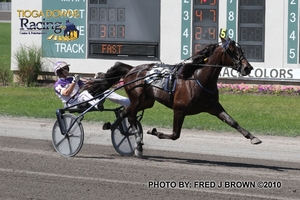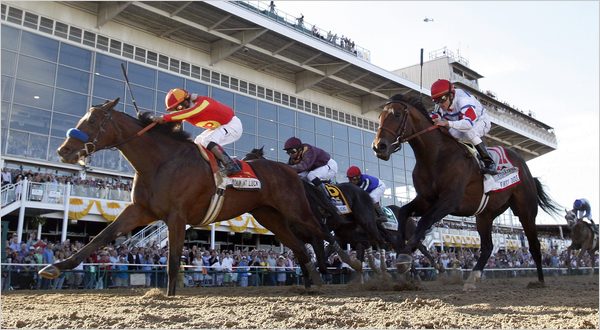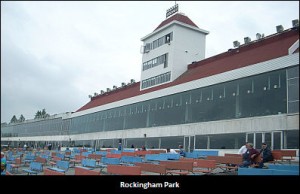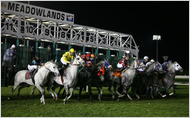|
The previous record was 153 flat set in 2009. From Harnessracing.com-
Temple Of Doom (above) set a world record at Tioga Downs on Sunday. Some of the best sophomore trotters in the world were gathered at Tioga for the 36th edition of The Harry M. Zweig Memorial Trot. 
Lucky Chucky was the horse collecting the headlines heading into the race, but in the first $134,965 division of the Zweig Memorial, Temple Of Doom and David Miller stole the show with a world record performance of 1:52.4 for 3-year old colt trotters on a five-eighths mile track.
The duo left from post position number five and trotted through fractions of :27.1, :57.2 and 1:25.1 before sprinting away from the field with long powerful strides with a final panel in :27.3. The mile eclipsed the world record set exactly one week ago by Lucky Chucky and John Campbell at Harrah’s Chester of 1:53, which was shared with Explosive Matter (Ron Pierce) from 2009.
Temple Of Doom posted only the second win of the career. The 3-year-old son of Yankee Glide-Armbro Temple is trained by Jonas Czernyson for Robert Rosenheim Stable.
“He had a bad post in the final of the Hambletonian and still raced good, and last week he raced really good at Chester. We have never put him on the front end but I decided to today and he raced as good as he ever has,” said winning driver David Miller. “I was a little surprised with the world record because we didn’t go that much in the second quarter, but he was sharp today and trotted right through the wire.”
Until Temple of Doom produces again, you have to wonder if he is a one race wonder. Much like Land Grant in a 1980′s edition of the Woodrow Wilson Pace.
 It was a perfect day for horse racing in Baltimore yesterday, and a great day to be Lookin At Lucky: It was a perfect day for horse racing in Baltimore yesterday, and a great day to be Lookin At Lucky:
BALTIMORE — He is a kid. Martin Garcia has been in this country for less than seven years and looks at the United States with a sense of wonder, whether from behind the counter of a Northern California delicatessen or now, through his racing goggles atop a thundering racehorse. On Saturday, as he led Lookin at Lucky onto the track for the Preakness Stakes, Garcia let loose a smile that would have been blinding atop a lighthouse.
Garcia drank in the pretty hats and the sports coats that dotted the grandstand at historic Pimlico. He took in the raucous infield, with its bleary-eyed revelers lifting their plastic mugs.
Behind him, Calvin Borel was stone-faced, crouched over Super Saver, the winner of the Kentucky Derby, and looking as if the weight of his Triple Crown aspirations had caved him in.
Not Garcia, 25. He was as happy as he was the night last week when the trainer Bob Baffert told him he would replace Garrett Gomez on Lookin at Lucky for this race. Garcia stayed up all night tickled by the possibilities.
Garcia had loved Lookin at Lucky ever since the first time he sat on the colt’s back for a workout last year.
For months, he worked Lookin at Lucky, last year’s 2-year-old champion, in the mornings only to hand him over to Gomez in the afternoons. Unfortunately for Baffert, Gomez had anything but luck with the colt in one troubled trip after another.
After Gomez and the colt were bounced around in the Derby and staggered in a hard-used sixth place, Baffert decided to make a change for the Preakness. Lookin at Lucky became Garcia’s mount.
When Garcia showed up in the paddock before the race and rattled off one “thank you†after another, Baffert wondered if his rider was perhaps unfocused and not ready to race.
“I think he’s so young, he doesn’t understand the magnitude of this race,†said Baffert, a Hall of Famer.
As Garcia loped Lookin at Lucky down the backstretch, however, Baffert’s doubts began to ease. His young jockey had listened to his instructions.
“I told him once you make the turn, you can’t be more than three paths off the rail,†Baffert said.
Garcia did as he was told. Now, he had the colt rolling like a riverboat, and Baffert was starting to feel pretty smart.
“I could see he had the horse in a nice rhythm,†Baffert said
Borel and Super Saver, on the other hand, were working hard and not looking all that comfortable chasing the long shot, First Dude, through a fast half-mile of 46.47 seconds, and a withering six furlongs of 1 minute 11.22 seconds.
And yes, First Dude was, at least in part, named after Todd Palin. First Dude’s mother ? Run Sarah Run.
On a more serious note, yesterday’s result means that, once again, there will be no Triple Crown winner this year. The last time it happened was in 1978 when Affirmed completed the task only a year after Seattle Slew had done it. This is already the longest gap between Triple Crown winners in history, the previous record being the twenty-five years between Citation and Secretariat.
It’s not surprising, really, winning three of the toughest races in horse racing is a difficult enough task in itself, and it’s become even harder as horse breeding has become a more exact science. There are a lot of good, fast horses out there, and it’s harder for just one of them to dominate the sport the way that others did in the past. There will probably be a Triple Crown winner someday, but its going to have to be one heck of a horse that accomplishes the task.
Bill Jempty Update- Lookin at Lucky’s Trainer Bob Baffert has announced that Lucky won’t race in the Belmont Stakes. Baffert said if Lucky was going for the Triple Crown, he’d enter the horse. Instead he will give a colt a rest. Last year’s Preakness winner, Rachel Alexandra, didn’t race in the Belmont either.
I understand the decision made by Baffert. Lookin at Lucky has little to gain from running in the Belmont(The endurance race of the Triple Crown. It is a mile and a half in length) and there is always the element of risk. Race horses are very fragile animals. Case in point, 2006 Kentucky Derby winner Barbaro. One bad step can lead to them needing to be destroyed. Maybe these races should be more spread out to encourage horses to race in all three. The Harness and Trotting Triple Crowns aren’t raced in just five weeks.
It was not the biggest payout in Puerto Rico history. From the Daily Racing Form-It was
Camarero Race Track in Puerto Rico paid out $4.94 million to a single winner of its Poolpote, a pick six-type bet, on Monday, an amount that exceeds the record payout for a pick six in the U.S. but is only one-third of the record for the Poolpote in Puerto Rico.
Like the U.S. pick six, the Poolpote requires a bettor to pick the winner of six consecutive races. However, the Poolpote only pays out its full jackpot if a single bettor holds the winning ticket. If multiple bettors have winning tickets, a consolation payout is made, and the pool carries over.
According to Camarero, the winning ticket on Monday cost $10.30. The minimum wager for the bet is 35 cents.
The all-time record for a Poolpote payout was $14.2 million, distributed on March 7, 2007, which is believed to be a Western Hemisphere record for a horseracing payout. The winning bettor in that case purchased a $270 ticket. Later that year, a single winner won $6.2 million.
Some people bet hundreds or even thousands on Pick 6 tickets. Pete Rose got into tax evasion trouble when he had someone claim a Pick 6 for him when it was he and his associates who were the owners.
The last track in New Hampshire will now only host poker, bingo(!), and other events. From AP-
The age of live horse racing at New Hampshire’s Rockingham Park is over.
Rockingham Park President Edward M. Callahan says the decision to limit the location to simulcast thoroughbred, harness and greyhound racing came because of increased fees imposed by the state.
Timothy “Ted” Connors of the New Hampshire Racing and Charitable Gaming Commission calls it a sad, dark day for the state.
Callahan says the decision had to be made now to give 850 horsemen and seasonal employees time to make other arrangements for the summer.
My prediction for 2010 that a horse track would closing its doors has sadly come true. In light of the financial condition of the industry, I expect this won’t be the last.
Personal note- I went to Rockingham Park once with my father during the 1980′s. It was during one of my only two ever visits to New Hampshire.
Last week I blogged about police and regulators in Michigan looking into whether races were fixed at Michigan area horse tracks. ESPN’s Bill Finley has an interesting take on the subject.
The thought of race fixing conjures up images of bad guys sitting in smoked-filled rooms deciding which horses are going to be stiffed, how they’re going to bet the bogus races and how they’re going to divide up the huge loot they’re going to make. It’s the last part that is the key. Race fixing involves greed and greed involves making money, usually lots of it. In Michigan, anyone in the race-fixing business would be lucky to make minimum wage.
Harness racing in Michigan is small-time stuff and the pools at the state’s track are pathetically small. The feature race Saturday night at Northville Downs, the only track currently racing in Michigan, was a conditioned race with a $5,600 purse. The best race on the biggest night of racing during the week, it attracted all of $8,782 in wagering in the win, exacta, trifecta and superfecta pools. After the takeout, roughly $6,800 was returned to winning bettors.
In order to fix a race, you’d have to have at least three drivers in on the scam, not to mention some gamblers and maybe even a trainer or two. At the very minimum, five people would have to be involved. Much of the pool would be taken down not by the race-fixers, but by gamblers who honestly stumbled onto to the winning numbers. Whatever the exact math is, there’d be nothing but a few crumbs left for the five or so bad guys after they divvied up their winnings. Anyone in on a fix would be lucky to walk away with a couple hundred dollars.
The betting figures out of Northville last Saturday were not an aberration. Hazel Park handles the most of any Michigan harness track. It averaged $89,612 per card in handle for 2008, according to the most recent Michigan Gaming Control Board report to be released. The average daily handle at Sports Creek in 2008 was $24,238, which comes out to about $2,000 per race. Imagine making your living fixing races at Sports Creek. You’d be on food stamps.
Would anyone fix a horse race, risk their career and jail time, for, at the most, $200 or $300? I suppose it’s possible, but it’s hard to believe anyone could risk so much for so little.
Finley goes on to wonder if investigators really understand horse racing.
If the take numbers Finley cites are accurate, I don’t see how fixing would be on these tracks for the same reason he does. That goes my usual inclination to believe if an investigation is under way in sports, that there has to be substance to it.
I grew up being taken from one Midwest race track or county fair to another*during the years 1971-1974. In late 1973 over 20 people(including some of the country’s most famous drivers) were arrested in the New York area for fixing superfecta races. I remember this huge scandal very well but it is almost forgotten today. The handles in 1973 by the way were many times bigger then today. Most of those arrested were found not guilty in court, but this and some of my father’s stories about drivers holding back, I’ve always taken a jaundiced rule when the possibility of race fixing surfaces. This time I want to see more and won’t jump to conclusions.
*- I grew up on Long Island but my father’s horses raced out of tracks in New Jersey, Ohio, and the Chicago area. New York city are tracks had strict rules about minors attending the races. In fact I can count the times I saw races at Roosevelt and Yonkers on on hand. Whereas I been to Freehold, Atlantic City, Brandywine, Scioto, Sportsmans Park, and a couple other tracks probably 200 times all combined.
It isn’t Centaur’s only filing in the last six months. From Harnessracing.com-
Centaur LLC, owner of Hoosier Park Racing & Casino, announced Sunday, March 7 that the company has filed for bankruptcy in an effort to restructure and emerge with less debt. According to a company press release, Centaur and its subsidiaries, which include Hoosier Park, Fortune Valley Hotel & Casino in Central City, Colorado, and Valley View Downs & Casino, elected to file a voluntary bankruptcy petition under Chapter 11 to ensure that operations continue without interruption. Hoosier Park is slated to kick off an 80-day harness meet beginning March 25.
*****
This is not the first bankruptcy filing for Centaur. The Indianapolis-based company missed a scheduled $13.4 million interest payment on a $400 million-plus loan in October 2009. At the time, two of the company’s affiliated entities in the Valley View Downs project, Valley View Downs LP and Centaur PA Land LP, filed for voluntary Chapter 11 bankruptcy to help retain a racing permit in Pennsylvania.
I don’t know what else to say about this news except that its consistent with the current trend in horse racing. The industry isn’t profitable any more on a stand alone basis,
Search warrants were executed earlier this week. From the Detroit Free Press-
Authorities say they believe as many as 30 owners, drivers, trainers and gamblers conspired to fix the outcome of certain harness horse races run at three Michigan tracks.
The Michigan State Police and the Michigan Gaming Control Board executed search warrants today at three southeast Michigan homes as part of an ongoing investigation into fraudulent wagering at the tracks.
Police say the case involves races at Hazel Park Harness Raceway, Northville Downs and Sports Creek Raceway in Swartz Creek. The tracks themselves aren’t under investigation and have been cooperating with investigators.
People in Ontario aren’t investigating.
Horse racing in Michigan is in serious trouble. Racing meets were recently shortened due to lack of funds. This news, true or untrue, certainly can’t help. Who wants to gamble on something that could be fixed?
A betting establishment that wants to make customers happy. Isn’t that a oxymoron? From Harnessracing.com-
Starting Wednesday, Feb. 24, Meadowlands bettors will be given additional handicapping information for each race. In most races, there are several drivers who are named to drive more than one horse when entries are made. Drivers have to decide which horse they will drive a few days prior to the printing of the racing program. A new television graphic will now show these choices.
If a driver was listed on multiple horses in a race, the graphic will list those horses and indicate the drivers choice.
“Many bettors feel driver choices are one of the most important handicapping angles at the track and several of our fans have requested a way to obtain that information,” said director of simulcasting and track announcer Sam McKee.
This is probably more related to simulcast rather than live racing. When I’ve been to the horse races, any change of driver or scratches were announced as betting opened on that particular race.
It is very important to know who is in the sulky when betting a harness race. In my early betting days, my father laughed when he heard I bet on a horse driven by Al Olori(?). Dad said to me “He can’t drive around the track without the help of a map.” The horse I bet on finished 6th or 7th and I learned an important lesson.
It is not often that some aspect of Harness racing gets written up in the New York Times.
Meadowlands Racetrack has had some of the highest-quality harness racing in the country and dozens of the sport’s most important races. But in recent years, the track has become a money-losing drain on the state of New Jersey, which now threatens its survival.
A report issued this month by a committee put together by Gov. Christopher J. Christie before his inauguration to come up with solutions to the financial problems of the New Jersey Sports and Exposition Authority made several suggestions that, if put in place, could all but gut the state’s racing industry. The suggestions included possibly closing Meadowlands Racetrack and drastically reducing the number of racing days at Monmouth Park.
The Sports and Exposition Authority is a state-run agency that owns the Meadowlands, Monmouth Park and portions of the state’s off-track betting system. The committee projected that the Meadowlands and Monmouth would lose a combined $22 million in 2010, a loss some lawmakers find difficult to justify given the state’s fiscal crisis.
In the report, the committee insisted that “the status quo is not sustainable†when it came to New Jersey racing.
“We know that the frankness of that report will have raised fears with certain interested groups and constituencies,†said Michael Drewniak, a spokesman for Christie. “In a sense, we’re glad that happened because if it wasn’t clear to everyone that these are the realities, it should be clear.â€
I’m well aware of the financial realities the horse racing industry is facing at present. In spite of infusions of public money, or more often than that the addition of some form of casino gambling to race tracks, the sport continues to struggle. There just aren’t as many people interested in the ‘Sport of Kings’ as there were when my father took me and my other siblings to the races in Pennsylvania, Ohio, New Jersey, Deleware, and Illinois when we were growing up.
Here are just a few of the posts I’ve written on horse racing’s financial woes.
Kentucky horse racing ‘in serious jeopardy’
Florida horsemen say 2009 racing meet will end 3 months early
New York Racing Association files for bankruptcy
Owner of Pimlico racecourse defaults on loan*
Rosecroft Raceway ceases operations
Freehold Raceway cuts purses, Meadowlands could be next**
*- Like the Meadowlands which hosts ‘The Hambletonian, Pimlico hosts another one of the sports grandest events- ‘The Preakness. When tracks like these can’t make money, it should be a clear sign just how troubled the sport is.
**- This post which was about New Jersey horse racing difficulties, was posted on 1-22-08.
I’ve got many more posts like the six listed above. Since I began contributing at OTB Sports in May 2006, there have been 74 horse racing posts written. Over 30% of which we re on the sports’ dire financial condition.
Should the state of New Jersey bail out the industry? Absolutely not. I love horse racing but the industry if it can’t survive on its own should cease operations. The government shouldn’t be in the business of trying to prop up any business. Public resources should be used for something more fruitful, not be wasted on something that will fail eventually even with the assistance.
On a side note. Why did the NY Times use a thoroughbred racing photo to accompany an article that specifically states harness racing in the very first paragraph? Harness racing is to horse racing, what the LPGA is to professional golf, a Rodney Dangerfield. Harness racing, even when its greatest events are taking place, barely get noticed by the media. No one need look further than both sports 3-year-old Triple Crowns. Has The Messenger Stakes, always raced in the New York City area, ever been on network television. I know it hasn’t from 1970 on.
Penn National Race Course is located 17 miles east of Harrisburg. From AP-
A central Pennsylvania racetrack is asking state officials to investigate a New Hampshire horseman after 10 of his horses were euthanized on the track in 13 months – two last week alone.
Penn National Race Course jockeys have refused to ride this week on or against horses owned by Michael Gill.
Penn National says eight Gill horses broke down last year and two more last week. Several jockeys tumbled Saturday when Gill’s Laughing Moon collapsed after a third-place finish.
Ten horses having to be killed is a lot but race horses are fragile animals being used at high speed. There is a good size element of risk involved.
Nevertheless, a investigation should be conducted. At the very least if Gill is innocent he should have his name cleared.
|
|













